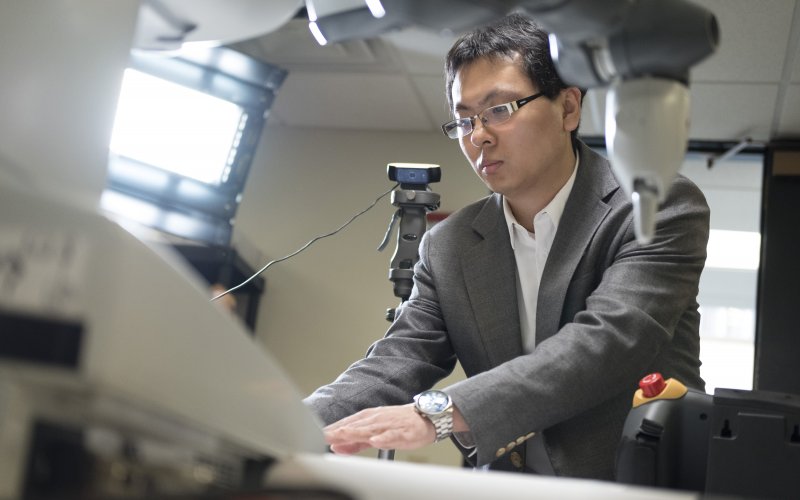Robots and the Future of Construction

Assistant Professor of Electrical and Computer Engineering Weifu Wang is leading a new project that aims to develop lightweight robots that could be utilized in a number of ways involving infrastructure.
Can an army of robots be deployed to form the bridges and tunnels of the future? A new project led by Weifu Wang, an assistant professor of Electrical and Computer Engineering at UAlbany’s College of Nanotechnology, Science, and Engineering aims to develop lightweight robots that could be utilized in a number of ways involving infrastructure.
Funded by a $271,926 grant from the National Science Foundation, the project explores how flexible robots can be designed to locomote and join together to form larger structures, such as temporary antennas, tent supports, bridges, or tunnel reinforcements. The project holds the potential to revolutionize the fields of exploration, search and rescue and disaster relief projects.
“The importance of the project lies in the development of lightweight robots and large-scale systems of robots that can be deployed quickly to form temporary infrastructure,” said Wang. “Novel designs of flexible robots – and the hardware and software systems to control them –advance the fields of robotics, automated control, and mechanical design.”
Wang points to a number of societal benefits that could come from the project, including humanitarian aid and disaster relief. Disasters ranging from virus outbreaks to coastal storms require quick deployment of infrastructure, such as wireless antennas for restoring communication, scaffolding for restoring power or tents for impromptu patient care.
“In the aftermath of a disaster, whether natural (wildfires, hurricanes, tornadoes, floods, earthquakes) or human-caused (war, terrorism), the restoration of infrastructure and essential services over wide areas is critically important,” said College of Engineering and Applied Sciences Dean Kim L. Boyer. “The longer these areas go without relief, the greater the impact on human lives, as we have seen recently and most vividly along the US Gulf Coast and in the American West. The effect of climate change has been to increase both the severity and frequency of these events. Prof. Wang is creating an entirely new approach to rapid-response, wide-area disaster recovery, exemplifying the college mission of ‘Science in Service to Society.’”
“Prof. Wang’s new grant is a great addition to the wide range of funded research within Electrical and Computer Engineering at UAlbany,” said Gary J. Saulnier, Professor and Chair of Electrical and Computer Engineering at CEAS. “The work will improve the ability to respond to disasters while advancing the robotics field and, importantly, providing our students the opportunity to learn and work at the leading edge of the technology.”
“The design of these robots centers around the principle of tensegrity: structures that contain rigid components that provide structural integrity, and flexible components that distribute forces and allow robots adapt in shape to their environment,” continued Wang.
This necessitates an end-to-end exploration of the mechanical designs, state estimation, planning and control systems that enable a novel class of flexible modular robots that deploy and assemble to form larger structures.
The project will design tensegrity robots with predictable and capable locomotion capabilities, as well as with docking mechanisms to allow the formation of larger structures from systems of robots, according to Wang.
The project will also be supported through the development and sharing of open-source design kits and software packages to help with experiment replication and use in hands-on educational activities, as well as interdisciplinary workshops and outreach activities to involve members of underrepresented groups.


